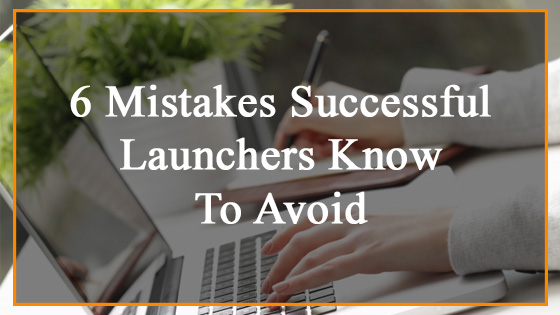
6 Mistakes Successful Launchers Know To Avoid
Tomesia 0 Comments Brand Launch Launch Offer Launch Strategy Planning
Anyone who has ever launched a new product will tell you, it’s definitely not enough to just show up and start marketing your launch offering and actually expect things to work out; most launches die out pretty quickly or slowly flop, which leads to a lot of lost time and money.
Sometimes a failed launch is due to bad luck or bad timing, but more often than not, they’re the result of careless mistakes made during the launch and even the post-launch process.
So today, I want to cover six of the most common mistakes the more successful and experienced launchers know to avoid making.
Mistake #1: Not defining and testing your idea first
One of the most important things to consider and remember is that your launch is doomed to fail if there’s no demand for it.
So before you set out to launch ANYTHING, make sure you first sit down and define your value proposition by answering some key questions like: Is there a need for this product? Does this product connect with the people I plan to market it to? What is the market willing to pay for it? What need is it serving?
Try creating a survey using SurveyMonkey and send it to your existing clients & customers or you could even share the survey on your social media platforms and gage the feedback you receive from there.
Mistake #2: Not defining your ideal target audience
Defining your target audience goes hand-in-hand with establishing a need for your launch offering.
Think about it, if you don’t know who is supposed to buy your product, how can you create an effective marketing plan, sales plan, and even your launch strategy?
The key here is to answer a few questions, as well. Make sure to ask yourself things like: Who is most likely to use this product? How big is the market for this product? What are the most effective ways for me to reach this group?
Spend some time searching online for resources that will help you get statistics on your ideal target audience. This may take a bit of time but it is well worth the effort to ensure a more successful launch.
Mistake #3: Not developing a full-fledged marketing plan and launch strategy
Once you’ve established a value proposition for your product and defined your ideal core audience, it’s now time to develop an in-depth marketing plan and launch strategy.
The key here is paying attention to detail. Simply outlining a few ideas and marketing channels is not enough. You need a lot more details than simply to say “we’re going to have a launch party, then do some search engine marketing, social media promotion, and maybe a webinar”.
You should have the core messaging and product benefits outlined, cover the full cycle from building awareness to encouraging fast buying action, define which marketing platforms will be used in which ways, clearly assign a budget, summarize the timeline and a lot more.
Mistake #4: Not scheduling properly
Speaking of timelines, one of the biggest mistakes made when launching is poor scheduling.
This is most clearly and most often seen in setting an unrealistic launch date. A launch date that is too aggressive more often than not, leads to postponements and sometimes even cancellations of the launch all together.
Timeline failures also go beyond just the launch day. With a new product there are countless earlier dates—development, marketing, sales, etc.—that must be met for a successful launch.
Mistake #5: Failing to soft-launch/beta test
Does your new product actually work? Are there any major bugs/issues? These questions are essential to answer, and they should be dealt with before your launch.
While businesses understandably want to rush to market their launch offerings, it’s extremely helpful to build in time for a lengthy soft-launch period. This can be done with beta offerings for digital products, tester versions for physical products, and even sneak-peeks for brick-and-mortar businesses.
Doing this has two key benefits. First, it allows you to iron out any big problems before launching—making early buyers happier and avoiding bad reviews/press.
Second, and just as important, a properly structured soft-launch period can build interest and even a sense of community.
Mistake #6: Not tracking performance closely post-launch and prepping for different outcomes
Finally, here’s something to know right off the bat: Product launches never go exactly according to plan, and that’s okay.
However, it’s not okay if you don’t know what’s happening post-launch and you aren’t prepared to deal with new or changing events. To avoid this, make sure to closely monitor performance and your contingency plan as much as possible.
Again, all of this is dependent on measurement. By regularly looking at core metrics—sales, traffic, etc.—you can see exactly how your launch offering is performing. These insights will let you make quick, informed decisions, which will ultimately give your launch a much better chance of success.













